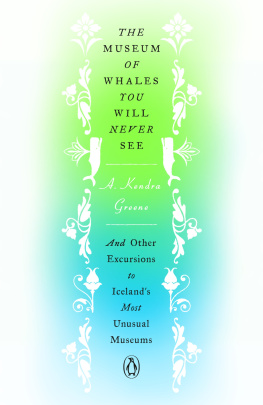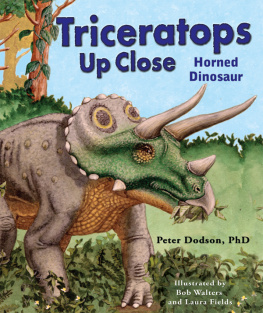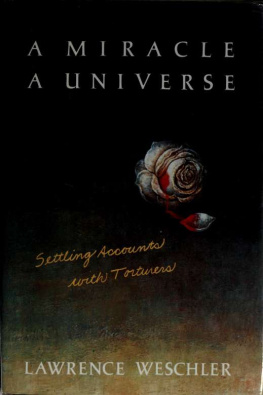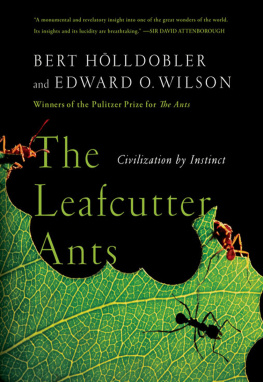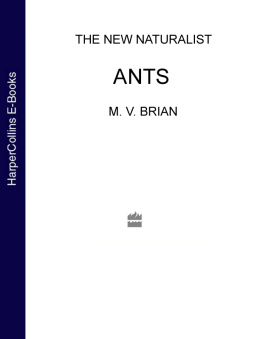Acclaim for Lawrence Weschlers
MR. WILSONS CABINET
of WONDER
A gem of a book by turns irony-laden and seriously charged a witty, discursive exploration that manages to encompass the very idea of the museum itself.
Newsday
A brilliant meditation on human creativity.
New York magazine
Weschler is a nonfiction writer with a poets ear.
The New York Times Book Review
Teems with ambiguity and amazement. The more we read of the Museum of Jurassic Technology, the more dizzyingly vague is the border between illusion and reality.
Seattle Times
A delightful book whose plot is pure curiosity and whose subject is the beauty of things that cant be known for sure.
Ian Frazier
This is travel literature of the rarest, most elegant sort: a book that recounts a journey of the mind. Lawrence Weschler has ventured into the strange and murky zone between the real and the imaginary and he proves to be an excellent guide, persuading us to follow him by the sheer force of his wit and an unflagging sense of wonder.
Paul Auster
A small jewel of a book, as intricate and astonishing as the wonders it describes.
Kirkus Reviews
In this marvelous study of a bizarre museum and its self-mocking, polymath creator, Weschler finds an epiphany of that vast movement of discovery and wonder which created the first museums and that heady state of mindcompounded of collection mania, mad taxonomy, imaginative exuberance, and naif wonderwhich formed the prelude to modern science. I found it enthralling.
Oliver Sacks
Lawrence Weschler
MR. WILSONS CABINET of WONDER
Lawrence Weschler has been a staff writer for The New Yorker since the early 1980s, and is a two-time winner of the George Polk Award (for Cultural Reporting in 1989 and Magazine Reporting in 1992). Mr. Wilsons Cabinet of Wonder, which was a finalist for both the Pulitzer Prize and the National Book Critics Circle Award, constitutes the latest installment in Weschlers ongoing Passions and Wonders series, earlier volumes of which include Seeing Is Forgetting the Name of the Thing One Sees and Shapinskys Karma, Boggss Bills and Other True-Life Tales. His other books include David Hockneys Cameraworks; The Passion of Poland; and A Miracle, a Universe. He lives in Westchester County, New York, with his wife and daughter.

()
Also by Lawrence Weschler
A Miracle, a Universe:
Settling Accounts with Torturers
Shapinskys Karma, Boggss Bills
and Other True-Life Tales
David Hockneys Cameraworks
The Passion of Poland
Seeing Is Forgetting the Name of the Thing One Sees:
A Life of Contemporary Artist Robert Irwin

Charles Willson Peale, The Artist in His Museum (1822) ()
FIRST VINTAGE BOOKS EDITION, NOVEMBER 1996
Copyright 1995 by Lawrence Weschler All rights reserved under International and Pan-American
Copyright Conventions. Published in the United States by Vintage Books, a division of Random House, Inc., New York, and simultaneously in Canada by Random House of Canada Limited, Toronto. Originally published in hardcover by Pantheon Books, a division of Random House, Inc., New York, in 1995.
Portions of this book were previously published, in abridged form, in Harpers.
Grateful acknowledgment is made to the following for permission to reprint previously published material:RES: Excerpts from Inquiry as Collection by Adalgisa Lugli (RES, Autumn 1986). Reprinted by permission of RES.Jays Journal of Anomalies: Excerpts from articles by Ricky Jay (Jays Journal of Anomalies, vol. 1, no. 1, Spring 1994 and vol. 2, no. 1, Spring 1995). Reprinted by permission of Jays Journal of Anomalies, published by W&V Dailey, 8216 Melrose Avenue, Los Angeles, CA 90046.
The Library of Congress has cataloged the Pantheon edition as follows:
Weschler, Lawrence.
Mr. Wilsons cabinet of wonder / Lawrence Weschler.
p. cm.
eISBN: 978-0-307-83398-3
1. Museum of Jurassic TechnologyHistory. 2. Wilson, David. 3. Popular cultureUnited StatesHistory. 4. MuseumPhilosophy. 5. Collectors and collectingHistory. I. Title.
AM101.L725W47 1995
0695dc20 95-5996
Random House Web address: http://www.randomhouse.com/
v3.1

For Sara
my own living wonder

Nothing is too wonderful to be true.
M ICHAEL F ARADAY
Contents
PART I
Inhaling the Spore
PART II
Cerebral Growth
PART I

Inhaling the Spore
Megaloponera foetens (the Cameroonian
stink ant) with forehead rampant
D eep in the Cameroonian rain forests of west-central Africa there lives a floor-dwelling ant known as Megaloponera foetens, or more commonly, the stink ant. This large antindeed, one of the very few capable of emitting a cry audible to the human earsurvives by foraging for food among the fallen leaves and undergrowth of the extraordinarily rich rain-forest floor.
On occasion, while thus foraging, one of these ants will become infected by inhaling the microscopic spore of a fungus from the genus Tomentella, millions of which rain down upon the forest floor from somewhere in the canopy above. Upon being inhaled, the spore lodges itself inside the ants tiny brain and immediately begins to grow, quickly fomenting bizarre behavioral changes in its ant host. The creature appears troubled and confused, and presently, for the first time in its life, it leaves the forest floor and begins an arduous climb up the stalks of vines and ferns.
Driven on and on by the still-growing fungus, the ant finally achieves a seemingly prescribed height whereupon, utterly spent, it impales the plant with its mandibles and, thus affixed, waits to die. Ants that have met their doom in this fashion are quite a common sight in certain sections of the rain forest.
The fungus, for its part, lives on: it continues to consume the brain, moving on through the rest of the nervous system and, eventually, through all the soft tissue that remains of the ant. After approximately two weeks, a spikelike protrusion erupts from out of what had once been the ants head. Growing to a length of about an inch and a half, the spike features a bright orange tip, heavy-laden with spores, which now begin to rain down onto the forest floor for other unsuspecting ants to inhale.



